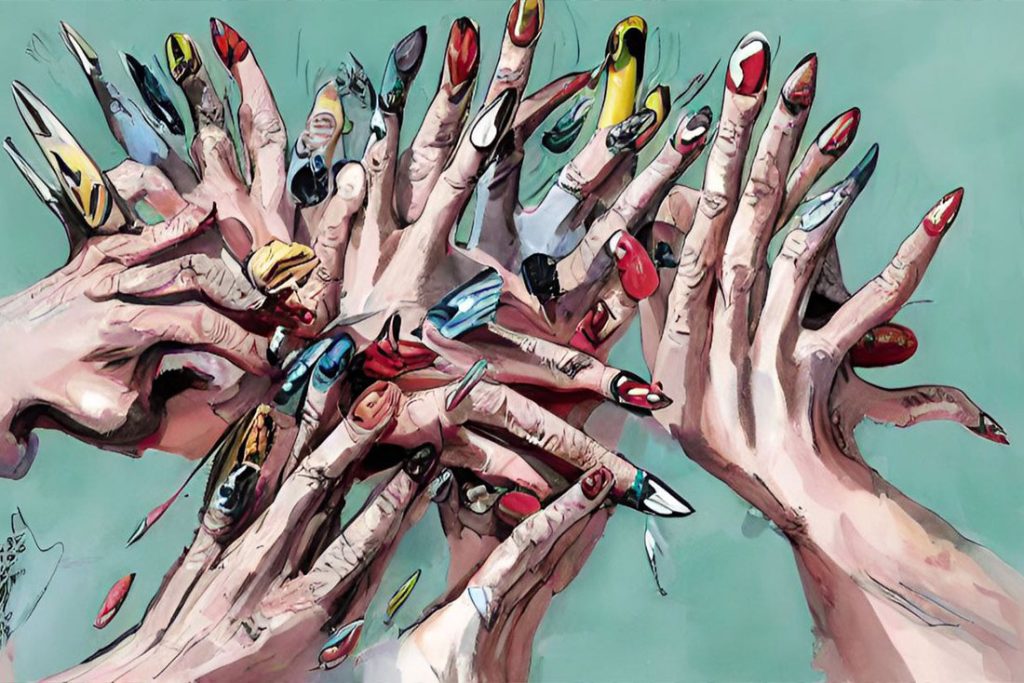Nail Diseases and the Role of a Cosmetologist: Navigating the Ethical Landscape
Our nails, often seen as a canvas for color and design, are also indicators of our health. The nail salon, therefore, becomes not just a place of pampering but a site where potential health concerns might first be noticed. Cosmetologists are at the forefront of this intersection, tasked with the dual role of beautifying nails and spotting abnormalities.

Nail Diseases
Understanding Nail Disorders
What is a Nail Disorder?
At the basic level, a nail disorder is a deviation from the nail’s normal appearance or functioning. Factors like genetics, injury, or underlying diseases can trigger these conditions.
Delving Deeper: Common Nail Disorders
While some of these disorders might seem harmless, understanding them helps a cosmetologist provide better care.
Overview of Nail Disorders | ||
Disorder | Signs or Symptoms | Image |
Beau’s lines | Depressions running across the nail plate’s width due to a slowing production of matrix cells, which causes the nail plate to grow thinner; usually the result of serious illness or injury |  |
Bruised nail bed | Dark purplish spots, usually due to a small nail bed injury; can usually be covered with nail polish or camouflaged with an opaque nail enhancement product |  |
Discolored nail | Nails turn a variety of colors; may indicate surface staining, a systemic disorder, or poor blood circulation |  |
Eggshell nail | Noticeably thin white nail plate is more flexible than usual; usually caused by poor diet, heredity, internal disease, medication, or overfiling with an abrasive; use caution when manicuring these fragile nails and minimize or avoid filing |  |
Hangnail | Damaged skin around the nail plate (often on the eponychium) becomes split or torn; can be carefully trimmed, provided the living skin is not cut or torn in the process |  |
Leukonychia | Whitish discolored spots on the nails, usually caused by minor injury to the nail matrix; often appear in the nails but do not indicate disease and disappear as the nail grows |   |
Melanonychia | Significant nail darkening caused by increased pigment cells (melanocytes), visible as a black band extending from the base to the free edge, or as a dark color over the entire nail plate |   |
Nail pterygium | Irregular stretching of the eponychium or hyponychium around the nail plate; usually from serious injury or an allergic skin reaction; creams or conditioning oils may be helpful, but never attempt to treat or push back nail pterygium with any instrument |  |
Onychophagy | Bitten nails; frequent manicures and proper hand care can help overcome this habit |  |
Onychorrhexis | Irregular split or brittle nails appearing as nail plate surface roughness; potentially caused by heredity, matrix injury, excessive exposure to cuticle removers, harsh cleaning agents, or aggressive filing techniques |  |
Pincer nail | Also known as trumpet nail; a form of dramatically increased nail curvature of the free edge, whereby the nail can curl in upon itself or may be deformed only on one sidewall; medical referral required in extreme or unusual cases or with painful conditions; using a brace-type product to straighten these nails is a medical practice and cannot be performed in a salon |  |
Plicatured nail | Also known as a folded nail; highly curved nail plate; may be inherited or caused by a matrix injury; often leads to ingrown nails |  |
Ridged nail | Lengthwise grooves in the plate, often mistaken for ridges; usually the result of aging |  |
Splinter hemorrhage | Damage to the capillaries under the nail, giving the appearance of a lengthwise small splinter underneath the nail plate; caused by physical trauma or nail bed injury |  |
Overview of Nail Disorders
Ethical Implications in Cosmetology
The Thin Line: Referring vs. Diagnosing
Cosmetologists are in a unique position where they often spot nail disorders first. However, they must tread carefully. Spotting a potential concern is within their purview; diagnosing it isn’t. It’s essential to kindly suggest clients see a medical professional without causing undue alarm.
The Client’s Well-being Comes First
If a client has nails that look infected or inflamed, or if there’s noticeable swelling or broken skin, salon services can exacerbate the problem. It’s the cosmetologist’s duty to prioritize health over aesthetics.
Navigating the License Parameters
A cosmetology license comes with clear parameters. No matter how much experience a cosmetologist might have, working on diseased or infected nails isn’t within their professional domain. Even with client consent or a doctor’s note, it’s crucial to stay within the license’s boundaries to ensure safety and professional ethics.
Infection Control: A Pillar of Cosmetology
A salon must be a haven of hygiene. By promptly identifying unhealthy nail conditions and following rigorous infection control methods, cosmetologists protect not just the client in question but every client that comes after.
The Bigger Picture: The Role of Cosmetologists in Public Health
The importance of a cosmetologist recognizing nail disorders extends beyond individual care. For instance, if a salon sees multiple clients with fungal infections, it could indicate a local outbreak. Cosmetologists can play a crucial role in early identification, potentially triggering public health interventions.
Moreover, cosmetologists often build close relationships with their clients. They can be instrumental in encouraging clients to seek medical attention when they might otherwise ignore or overlook a nail disorder.
Conclusion
The world of cosmetology isn’t just about beauty; it’s about care, attention, and responsibility. Recognizing nail disorders is a crucial aspect of a cosmetologist’s job, ensuring that the salon remains a place of both beauty and well-being. As science continues to uncover links between our external appearance and internal health, the cosmetologist’s role as a sentinel of health will only grow in importance.






